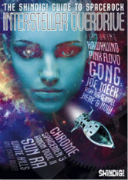Why do a “spacerock” guide and how did it come about?
I’d written a fair bit for Shindig over the last few years and pitched the idea of a book on spacerock. As it happened the publisher was looking for an idea for a new one-off ‘bookazine’ so it all came together perfectly. The only other focused gu ide to the genre is Dave Thompson’s Space Daze, which is good though not exhaustive. I really love spacerock so I thought there was an obvious market gap for a guide to the music ide to the genre is Dave Thompson’s Space Daze, which is good though not exhaustive. I really love spacerock so I thought there was an obvious market gap for a guide to the music
It's very detailed, informative and entertaining. How long did it take to put together?
About 8 months. As you can see there were a lot of other writers so it involved a lot of co-ordinating and fretting on my part to bring it all together! I was very lucky that brilliant writers like Marco Rossi, Ian Abrahams and Rich Deakin turned in such excellent work to support the project. I must also thank Richard Morton Jack who supplied informative archival material that helped steer the project. It was hard work to reach the deadline but amazingly we did so!
Spacerock is a broad canvas to be sure. Did you have any difficulty deciding who and what to include and what not to?
Very much so. If one thinks of the genre just as bands with sci-fi lyrics, heavy riffs and electronics then you would probably be left with very few bands. On the flip-side, you could look at ‘cosmic music’ in which case there are huge numbers of things that may merit inclusion.
I dwelt long and hard as to whether to include bands like Nektar and Eloy but ultimately I just don’t see it as real spacerock. On the reverse, bands like Spacemen 3 and Loop were a borderline inclusion - though I thought it interesting to ask them spacerock related questions as this is something that hasn’t been brought out in interviews before. Spacemen 3’s link to Hawkwind is rarely discussed for instance.
As with everything it’s hard to draw distinct lines between genres but ultimately it’s helpful for the listener in order to group together likeminded bands.
Over 170 or so pages you and your colleagues appear to have interviewed pretty much anyone who's anyone in spacerock. Short of employing a good Medium was there anyone you would like to have had participating who managed to elude you?
Pink Floyd! To be honest I didn’t even try to approach that machine given their obvious antipathy to the ‘spacerock question’. I would have liked to speak to Edgar Froese but he didn’t return emails which was a shame. Electronic Meditation and Alpha Centauri are just two incredible albums – totally beyond what anyone else was doing at the time. I was lucky generally that so many people responded to me – I would never have dreamt that Steve Hillage, Richard Pinhas, Manuel Gottsching, Dave Brock, Michael Rother et al would have spoken to us when the project began.
How happy are you with the critical and commercial response?
Almost everyone seems happy with the result, which is great. As originally anticipated the magazine was about 130 pages when the price was set - so coming in at 170 pages gives people a lot of bang for their buck! As with everything you’re never quite happy with it though. One of the blurry pictures we used to illustrate the Pink Floyd article is actually unlikely to be Pink Floyd for instance! I was so focused on grammar and spelling I missed this in the proofing which will annoy me for all eternity. Personally I’m really happy with the magazine overall though. Too often these days I’ll buy a magazine for a feature on a band I like only to find they’ve condensed their whole career into 3 scant pages. We spent 10 pages on 3 Gong albums! Obviously there’s a balance to be struck between tedious detail and a kinetic rock ‘n’ roll story but it’s a balance that the mainstream music press are getting totally wrong month after month.
What's the next big venture for you/ Shindig following this one and last year's Witches Hats and Painted Chariots tome? Shindig following this one and last year's Witches Hats and Painted Chariots tome?
I’m a bit burnt out now and enjoying time on the sofa! I would love to take on a book project in the future though. Amon Duul II have a great story and there’s relatively little written about them in English so that might be a reasonably project. I’m also focused on trying to find the Cardiff-based psych band Apple who have never been located and whose story I would love to tell.
Do you have a message for the Terrascope and its readers?
I first encountered Terrascope in Stand Out/Minus Zero Records back in the 2000s when the whole world of psychedelic music was opening up to me. I remember being bewildered at all these bands I’d never heard of – and realising there was a world of music outside of the NME. Terrascope played a big part in opening my eyes to it all. |

